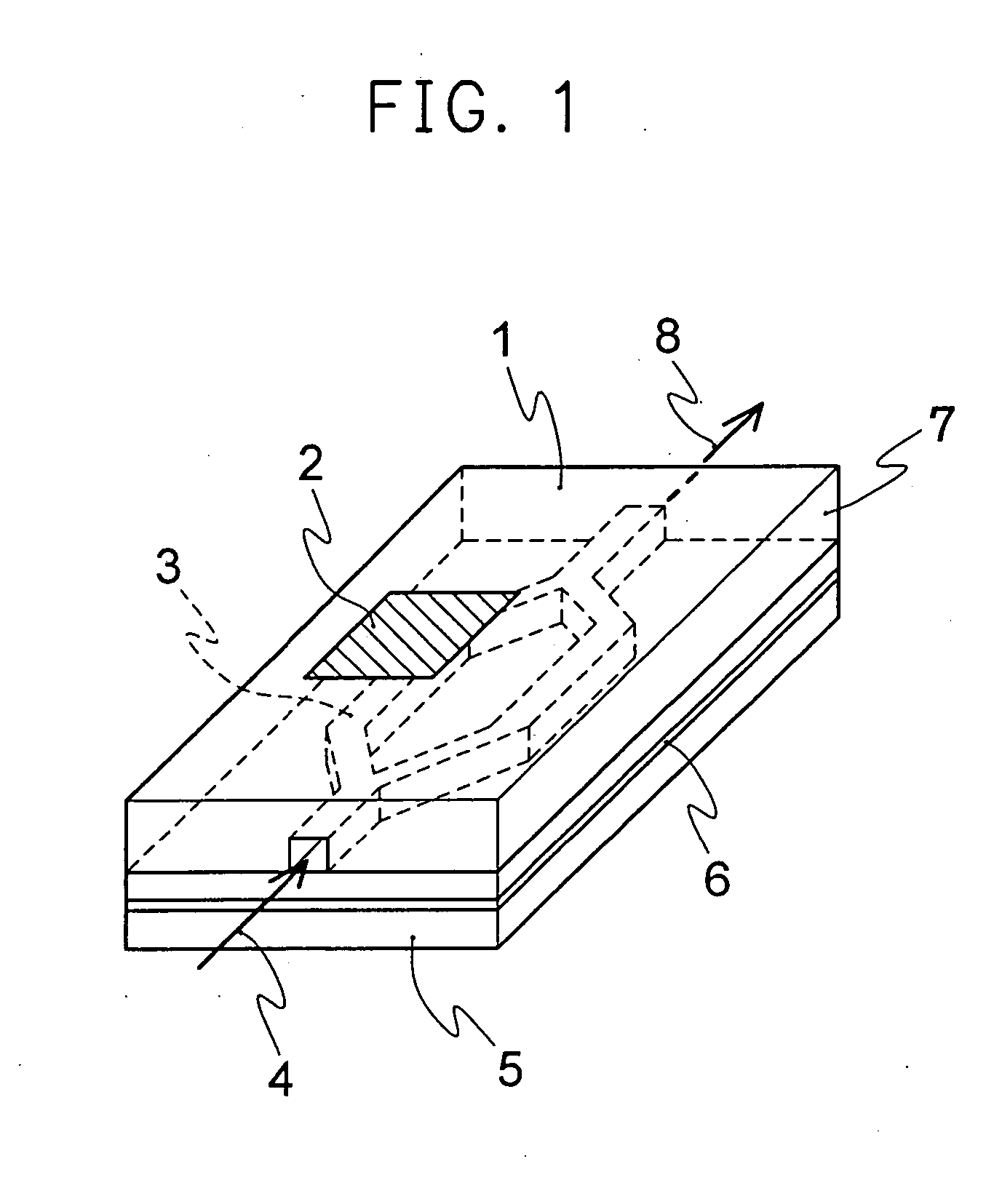Nonlinear optical materials comprising fluorine-containing polymer
a technology of optical materials and fluorine, which is applied in the direction of spectral modifiers, surgical adhesives, spectacles/goggles, etc., can solve the problems of poor productivity and processability, slow response speed, and limited frequency range, and achieve the effect of small light transmission loss
- Summary
- Abstract
- Description
- Claims
- Application Information
AI Technical Summary
Benefits of technology
Problems solved by technology
Method used
Image
Examples
preparation example 1
(Synthesis of Homopolymer of Fluorine-Containing Allyl Ether Having OH Group)
A 100 ml four-necked glass flask equipped with a stirrer and thermometer was charged with 20.4 g of perfluoro-(1,1,9,9-tetrahydro-2,5-bistrifluoromethyl-3,6-dioxanonenol):
and 21.2 g of a perfluorohexane solution of 8.0% by weight of:
[HCF2CF23COO 2
and after the inside of the flask was sufficiently replaced with nitrogen gas, stirring was carried out at 20° C. for 24 hours in nitrogen gas stream and a solid having a high viscosity was produced.
The obtained solid was dissolved in diethyl ether and then poured into perfluorohexane, followed by separating and vacuum-drying to obtain 17.6 g of a transparent colorless polymer.
According to 19F-NMR, 1H-NMR and IR analyses, the polymer was a fluorine-containing polymer consisting of the structural unit of the above-mentioned fluorine-containing allyl ether and having hydroxyl at an end of its side chain. The number average molecular weight of the polyme...
preparation example 2
(Synthesis of Copolymer of Fluorine-Containing Allyl Ether Having OH Group)
A 100 ml four-necked glass flask equipped with a stirrer and thermometer was charged with 9.6 g of perfluoro-(1,1,9,9-tetrahydro-2,5-bistrifluoromethyl-3,6-dioxanonenol):
and 9.6 g of methyl 9H,9H-perfluoro-2,5-dimethyl-3,6-dioxa-8-nonenoate:
followed by stirring sufficiently and then adding 2.0 g of a perfluorohexane solution of 8.0% by weight of:
[HCF2CF23COO2
and after the inside of the flask was sufficiently replaced with nitrogen gas, stirring was carried out at 20° C. for 20 hours in nitrogen gas stream and a solid having a high viscosity was produced.
The obtained solid was dissolved in acetone and poured into a solution of HCFC225 / n-hexane═1 / 1, followed by separating and vacuum-drying to obtain 15.5 g of a transparent colorless polymer.
According to 19F-NMR, 1H-NMR and IR analyses, the polymer was a fluorine-containing polymer comprising the structural unit of the above-mentioned fluorine-c...
preparation example 3
(Synthesis of Curable Fluorine-Containing Polymer Having α-fluoroacryloyl Group)
A 200 ml four-necked flask equipped with a reflux condenser, thermometer, stirrer and dropping funnel was charged with 80 ml of diethyl ether, 5.0 g of the fluorine-containing allyl ether homopolymer having hydroxyl which was obtained in Preparation Example 1 and 1.0 g of pyridine, followed by cooling to 5° C. or lower with ice.
A solution obtained by dissolving 1.0 g of α-fluoroacrylic acid fluoride CH2═CFCOF in 20 ml of diethyl ether was added thereto dropwise over about 30 minutes while stirring in nitrogen gas stream.
After completion of the addition, the flask temperature was raised to room temperature and the stirring was further continued for 4.0 hours.
The ether solution after the reaction was put in the dropping funnel, followed by washing with water, 2% hydrochloric acid solution, 5% NaCl solution and water and then drying with anhydrous magnesium sulfate. Then the ether solution was filt...
PUM
| Property | Measurement | Unit |
|---|---|---|
| wavelength | aaaaa | aaaaa |
| absorption coefficient | aaaaa | aaaaa |
| wavelength | aaaaa | aaaaa |
Abstract
Description
Claims
Application Information
 Login to View More
Login to View More - R&D
- Intellectual Property
- Life Sciences
- Materials
- Tech Scout
- Unparalleled Data Quality
- Higher Quality Content
- 60% Fewer Hallucinations
Browse by: Latest US Patents, China's latest patents, Technical Efficacy Thesaurus, Application Domain, Technology Topic, Popular Technical Reports.
© 2025 PatSnap. All rights reserved.Legal|Privacy policy|Modern Slavery Act Transparency Statement|Sitemap|About US| Contact US: help@patsnap.com



